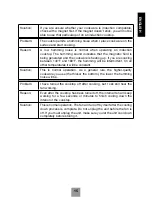
6
ENGLISH
IMPORTANT SAFEGUARDS
When using electrical appliances, basic safety precautions should always be followed.
Important safeguards to use include the following:
1.
Read all instructions carefully.
2. Do not touch hot surfaces. Use handles or pot holders when managing an electrical
appliance.
3.
To protect against electrical shock, do not immerse cord, plugs, or any electrical parts of the
appliance in water or other liquids.
4.
Close supervision is necessary when any appliance is used by or near children.
5.
Unplug the unit from the outlet when not in use and before cleaning. Allow to cool before
moving and/or cleaning the cooktop.
6.
Do not operate any appliance with a damaged cord/plug, after the appliance malfunctions
or if it has been damaged in any manner. Return the appliance to the nearest authorized
service facility for examination, repair, or adjustment.
7.
The use of accessories or attachments not recommended by the appliance manufacturer
may cause injuries to yourself or damage to your unit.
8.
Do not use outdoors.
9.
Do not let the cord hang over the edge of your table or counter, or touch hot surfaces.
10. Do not place on or near a hot gas or electric burner, or in a heated oven.
11. To disconnect, turn unit completely off and then remove plug from wall outlet.
12. Do not use appliance for anything but its intended use as described in this manual.
13. Do not cook on a broken cooktop; If the portable induction cooktop should break, cleaning
solutions and spillovers may penetrate the broken cooktop and create a risk of electric
shock.
14. Clean the cooktop with caution; If a wet sponge or cloth is used to wipe spills on a hot
cooking area, be careful to avoid steam burn. Some cleaners can produce noxious fumes if
applied to a hot surface.
15. Do not place metal objects such as knives, forks, spoons and lids on the surface of the
induction cooktop since the residual heat could potentially make the metal objects very hot.
16. The unit comes with a short power-supply cord to reduce the risk of a tripping hazard.
Longer extension cords may be used if necessary. If a long extension cord is used:
a) The electrical rating of the extension cord should be at least as great as the electrical
rating of the appliance.
b) The longer cord should be placed so that it will not drape over the counter top or table
top where it can be pulled on by children or tripped over unintentionally.
SAVE THESE INSTRUCTIONS









































